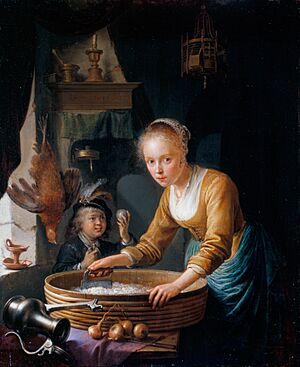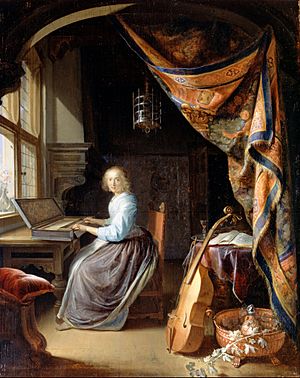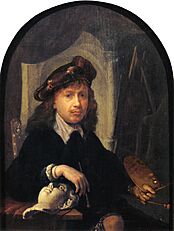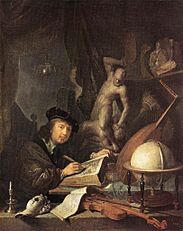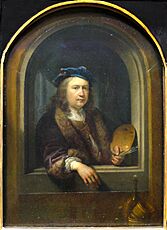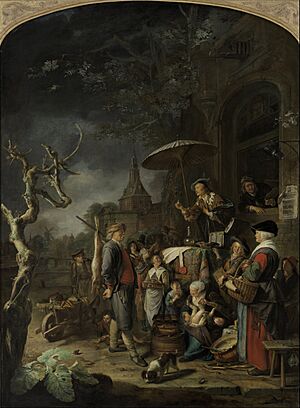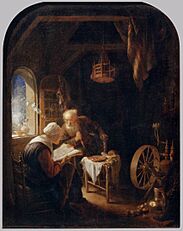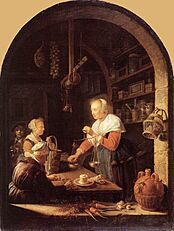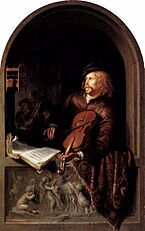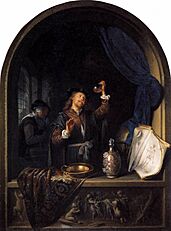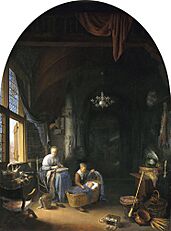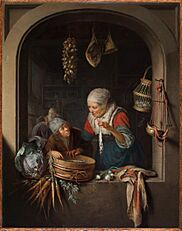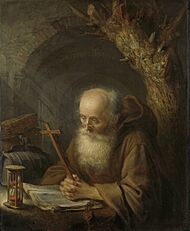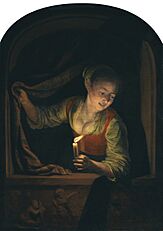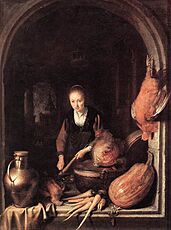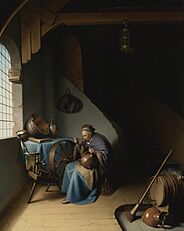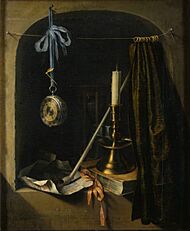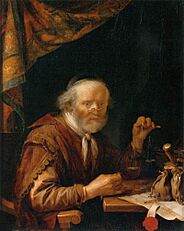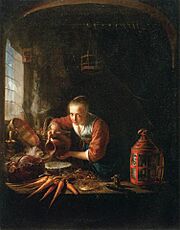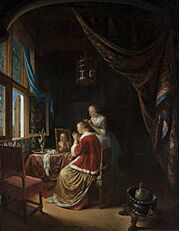Gerrit Dou facts for kids
Quick facts for kids
Gerrit Dou
|
|
|---|---|
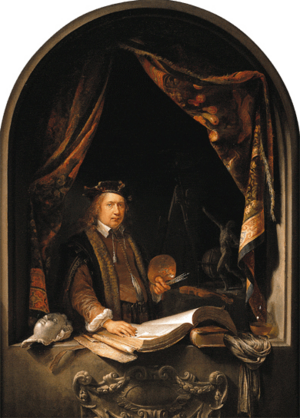
Self-portrait (c. 1665), Museum of Fine Arts, Boston
|
|
| Born | 7 April 1613 |
| Died | 9 February 1673 (aged 61) |
| Nationality | Dutch |
| Education | Rembrandt (master) |
| Movement | Leiden fijnschilder |
Gerrit Dou (7 April 1613 – 9 February 1675), also known as Gerard Douw or Dow, was a Dutch Golden Age painter, whose small, highly polished paintings are typical of the Leiden fijnschilders. He specialised in genre scenes and is noted for his trompe-l'œil "niche" paintings and candlelit night-scenes with strong chiaroscuro. He was a student of Rembrandt.
Contents
Life
Dou was born in Leiden, where his father was a manufacturer of stained-glass. He studied drawing under Bartholomeus Dolendo, and then trained in the stained-glass workshop of Pieter Couwenhorn. In February 1628, at the age of fourteen, his father sent him to study painting in the studio of Rembrandt (then aged about 21) who lived nearby. From Rembrandt, with whom he remained for about three years, he acquired his skill in colouring and in the more subtle effects of chiaroscuro, and his master's style is reflected in several of his earlier pictures, notably a self-portrait at the age of 22 in the Bridgewater Collection, and in the Blind Tobit going to meet his Son, at Wardour Castle [locations may be outdated].
At a comparatively early point in his career, however, he developed a distinctive manner of his own which diverged considerably from Rembrandt's, cultivating a minute and elaborate style of treatment. He is said to have spent five days in painting a hand, and his work was so fine that he found it necessary to manufacture his own brushes.
Notwithstanding the minuteness of his touch, the general effect was harmonious and free from stiffness, and his colour was always fresh and transparent. He often represented subjects in lantern or candle light, the effects of which he reproduced with an unparalleled fidelity and skill. He often painted with the aid of a concave lens combined with a convex mirror (the former sharpening perception, the latter providing a rightway-up image to paint from), and to obtain exactness looked at his subject through a frame crossed with squares of silk thread. His practice as a portrait painter, which was at first considerable, gradually declined, sitters being unwilling to give him the time that he deemed necessary. His pictures were always small in size. More than 200 are attributed to him, and examples are to be found in most of the major public collections of Europe. His chef-d'oeuvre is generally considered to be The Dropsical Woman (1663), and The Dutch Housewife (1650), both in the Louvre. The Evening School, in the Amsterdam Rijksmuseum, is the best example of the candlelight scenes in which he excelled. In the National Gallery, London, favorable specimens are to be seen in the Poulterer's Shop (1672), and a self-portrait (see above). Dou's pictures brought high prices, and one patron, Pieter Spiering, who acted as Swedish Ambassador in The Hague from the mid-1630s, paid him 500 guilders annually simply for the right of first refusal of his latest works. Queen Christina of Sweden owned eleven paintings by Dou, and Cosimo III de' Medici visited his house, where he may have bought at least one of the works now in the Uffizi. The Dutch royal court itself, however, preferred work of a more classical tendency.
Dou died in Leiden. His most noted pupils were Frans van Mieris the Elder and Gabriël Metsu. He also taught Bartholomeus Maton, Carel de Moor, Matthijs Naiveu, Abraham de Pape, Godfried Schalcken, Pieter Cornelisz van Slingelandt, Domenicus van Tol, Gijsbert Andriesz Verbrugge, and Pieter Hermansz Verelst.
- Gerrit Dou's self-portraits
-
Self-portrait, c. 1650, Rijksmuseum Amsterdam
Posthumous reputation
Dou's work commanded high prices long after his death, until the 1860s. Soon after, he fell into near complete obscurity. For example, when the Metropolitan Museum of Art held in an exhibit to introduce Dutch art, it featured 37 by Rembrandt, 20 by Hals, but none by Dou. His obscurity continued until the 1970s when his reputation was reestablished and has continued since.
Works
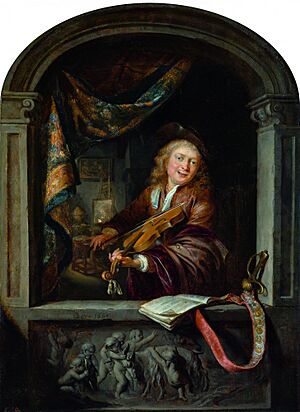
- The Night School (Rijksmuseum, Amsterdam)
- 1628: Astronomer (Hermitage Museum, Saint Petersburg)
- 1631.1632 Old Woman Reading (formerly known as Rembrandt's Mother) (Rijksmuseum, Amsterdam)
- 1630s: Portrait of a Girl (Manchester Art Gallery, UK)
- 1631: Prince Rupert (J. Paul Getty Museum, Los Angeles)
- 1635–1636: Still Life with a Boy Blowing Soap-Bubbles (National Museum of Western Art, Tokyo)
- 1635–1640: Portrait of a Man (National Gallery, London)
- 1637: An Interior with a Young Violinist (National Galleries of Scotland)
- 1640s: Portrait of a Young Woman (National Gallery, London)
- 1640–1645: Portrait of a Man (Hermitage Museum, Saint Petersburg)
- 1642–1647: St. Jerome in the Desert (Memorial Art Gallery of the University of Rochester, New York)
- 1645: The Schoolmaster (Fitzwilliam Museum, Cambridge)
- 1646: Girl Chopping Onions (Royal Collection, London)
- 1647: Still Life With Book and Purse (J. Paul Getty Museum, Los Angeles)
- 1650: The Dutch Housewife (Louvre, Paris)
- 1650s: The Young Mother (Gemäldegalerie, Berlin)
- 1650s: Self Portrait (Rijksmuseum, Amsterdam)
- 1650s: Self-portrait at the Window (Residenzgalerie, Salzburg)
- 1658-1665: Young Woman with a Lighted Candle at a Window (Thyssen-Bornemisza Museum, Madrid)
- 1652: The Quack Doctor (Museum Boymans-van Beuningen, Rotterdam)
- 1653:The Physician (Christchurch Art Gallery Te Puna o Waiwhetu, Christchurch, New Zealand)
- 1653: The Violin Player (Liechtenstein Palace, Vienna)
- 1655: Old Woman Cutting Bread (Museum of Fine Arts, Boston)
- 1655: Astronomer by Candlelight (J. Paul Getty Museum, Los Angeles)
- 1658: The Young Mother (Mauritshuis, The Hague)
- 1660s: The Nursery (Lost with the sinking of the Vrouw Maria in 1771)
- 1660–1665: Dentist by Candlelight (Kimbell Art Museum, Fort Worth)
- 1660–1665: Old Woman Unreeling Threads (Hermitage Museum, Saint Petersburg)
- 1660–1665: Soldier Bather (Hermitage Museum, Saint Petersburg)
- 1660-1665: Woman Bather (Hermitage Museum, Saint Petersburg)
- 1660-1665: Self-portrait (Louvre, Paris)
- 1661: A Hermit (Wallace Collection, London)
- 1663: The Dropsical Woman (Louvre, Paris)
- 1663: Woman at a Window with a Copper Bowl of Apples and a Cock Pheasant (Fitzwilliam Museum, Cambridge)
- 1665: A Lady playing a Clavichord (Dulwich Picture Gallery, London)
- 1670: A Hermit Praying (Minneapolis Institute of Arts, Minnesota)
- 1670: The Hermit (National Gallery of Art, Washington, D.C.)
- 1670s: A Poulterer's Shop (National Gallery, London)
- 1670–75: The Herring Seller (Hermitage Museum, Saint Petersburg)
- Self Portrait (National Gallery, London)
- Portrait of a Young Man (Fitzwilliam Museum, Cambridge)
- Evening Light (Rijksmuseum, Amsterdam)
- Young Man (The Hague)
- The Cook (Louvre, Paris)
- The Spinner (Gala-Salvador Dalí Foundation)
- The Spinning Reel (Fine Arts Museums of San Francisco)
- The Reader (Fine Arts Museums of San Francisco)
- Portrait of an Unknown Gentleman (Museum of Fine Arts at the University of Montana, Missoula)
- Dog at Rest (Museum of Fine Arts, Boston)
- Gerrit Dou's works
-
Reading the Bible, c. 1645, Louvre
-
The Grocer's Shop, 1647, Louvre
-
Dutch Housewife, 1650, Louvre
-
The Physician, 1653, Kunsthistorisches Museum, Vienna
-
A Hermit, 1664, Rijksmuseum
-
Old Woman Cutting Bread, c. 1655, Museum of Fine Arts, Boston
-
The Silver Ewer c. 1663, Louvre
-
The Moneylender, c. 1664, Louvre
-
Woman Pouring Water into a Jar, from 1655 until 1665, Louvre
See also
 In Spanish: Gerrit Dou para niños
In Spanish: Gerrit Dou para niños


